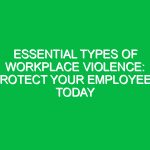Introduction
In the ever-evolving landscape of health, safety, and Environment (HSE) management, personal protective equipment (PPE) stands as a critical line of defense against workplace Hazards. PPE encompasses a wide range of gear designed to protect individuals from various risks, including physical, chemical, biological, and radiological Hazards. By understanding the essential Types of PPE equipment and their relevance in the HSE domain, organizations can significantly enhance their Safety protocols and ensure a secure work environment for their employees.
This article delves into the various types of PPE equipment, exploring their functions, benefits, and Best Practices. Whether you work in construction, healthcare, manufacturing, or any other high-risk sector, knowing the right PPE to use can make all the difference in safeguarding your health and wellbeing.
Understanding PPE in the HSE Context
PPE is defined as any clothing, equipment, or other item designed to be worn by individuals to minimize exposure to a range of hazards. In the context of HSE, the types of PPE equipment are essential for protecting workers from injuries and illnesses that could arise from their work environments. The effectiveness of PPE is contingent upon its proper selection, use, and Maintenance.
While PPE is not a substitute for more effective hazard Control Measures, such as eliminating or engineering out risks, it plays a vital role when such measures are insufficient. By providing an additional layer of protection, PPE helps ensure that workers can perform their tasks safely while minimizing the risk of injury or illness.
Key Types of PPE Equipment
When it comes to PPE, various types cater to specific hazards and risks. The following sections outline the essential types of PPE equipment, highlighting their functions, applications, and Best Practices.
1. Head Protection
Hard hats are the most recognized form of head protection. They are designed to shield the head from falling objects, electrical shocks, and other potential hazards.
- Types of Hard Hats: There are two main types of hard hats: Type I, which provides protection against vertical impacts, and Type II, which offers protection against both vertical and lateral impacts.
- Best Practices: Ensure hard hats fit properly and are worn in designated areas. Regularly inspect for cracks and damages, and replace them when necessary.
2. Eye and Face Protection
Protective eyewear, including Safety Glasses, goggles, and face shields, is crucial for safeguarding against flying debris, chemical splashes, and intense light.
- Safety Glasses: These are designed to protect against impact and dust. They often have side shields for additional protection.
- Goggles: These provide a snug fit around the eyes and are ideal for chemical handling or working with hazardous materials.
- Face Shields: Used in conjunction with Safety glasses or goggles, face shields protect the entire face from hazardous materials.
- Best Practices: Choose the appropriate eyewear for specific tasks and ensure they meet the relevant safety Standards.
3. Hearing Protection
Noise-induced hearing loss is a significant concern in many workplaces, particularly in manufacturing and construction.
- Types of Hearing Protection: Earplugs and earmuffs are common forms of hearing protection. Earplugs fit inside the ear canal, while earmuffs cover the entire outer ear.
- Best Practices: Conduct regular noise assessments and provide appropriate hearing protection based on exposure levels. Train workers on the correct use and maintenance of hearing protection devices.
4. Respiratory Protection
Respirators are essential for protecting workers from inhaling harmful substances, including dust, fumes, vapors, and gases.
- Types of Respirators: There are two main categories: air-purifying respirators (APRs), which filter contaminants from the air, and supplied-air respirators (SARs), which provide clean air from an external source.
- Best Practices: Conduct fit testing to ensure a proper seal, and provide Training on when and how to use respiratory protection. Regularly inspect and maintain respirators to ensure their effectiveness.
5. Hand Protection
Hand injuries are among the most common workplace incidents, making gloves an indispensable form of PPE.
- Types of Gloves: There are various types of gloves designed for specific hazards, including chemical-resistant gloves, cut-resistant gloves, and heat-resistant gloves.
- Best Practices: Assess the specific hazards of the task at hand and select gloves that offer the appropriate level of protection. Regularly inspect gloves for wear and damage and replace them as needed.
6. Body Protection
Body protection includes protective clothing that safeguards against various hazards, such as chemicals, heat, and cuts.
- Types of Protective Clothing: This category includes coveralls, aprons, and vests, each designed for specific applications and hazards.
- Best Practices: Ensure protective clothing is appropriate for the specific task and hazard. Train workers on the proper use and maintenance of these garments.
7. Foot Protection
Foot injuries can lead to serious consequences, making safety footwear a critical component of PPE.
- Types of Safety Footwear: Steel-toed boots protect against crushing injuries, while slip-resistant soles help prevent falls.
- Best Practices: Ensure footwear fits properly and is appropriate for the work environment. Regularly inspect for wear and tear.
8. Fall Protection
For workers at heights, fall protection is essential to prevent serious injuries or fatalities.
- Types of Fall Protection: Harnesses, lanyards, and guardrails are common fall protection equipment used in various industries.
- Best Practices: Implement a fall protection plan that includes training on the proper use of equipment and regular inspections of fall protection systems.
Regulations and Standards Governing PPE
Compliance with Regulations and standards is essential for effective PPE use. Various organizations, including the Occupational Safety and Health Administration (OSHA) in the United States, provide guidelines on PPE selection, use, and maintenance.
- osha Standards: OSHA mandates that employers conduct hazard assessments to determine the necessary PPE for their workers. The standards also outline requirements for training, maintenance, and proper use of PPE.
- ANSI Standards: The American National Standards Institute (ANSI) sets forth standards for the performance and testing of various types of PPE, ensuring that equipment meets specific safety criteria.
Failure to comply with these regulations can lead to legal repercussions and, more importantly, increased risks to worker safety. Organizations should prioritize staying updated on relevant regulations to ensure compliance and protect their workforce.
Conclusion
Understanding and utilizing the essential types of PPE equipment is fundamental to promoting health, safety, and environmental Sustainability in the workplace. From head protection to fall protection, each category of PPE serves a vital purpose in mitigating risks and preventing injuries.
Organizations must prioritize the selection, proper use, and maintenance of PPE to create a culture of safety. By fostering an environment where safety is a shared responsibility, employers and employees can work together to protect their health and wellbeing.
In conclusion, investing time and resources into proper PPE practices not only safeguards workers but also enhances overall productivity and morale. Protect your safety today by understanding the types of PPE equipment available and implementing best practices in your workplace.


